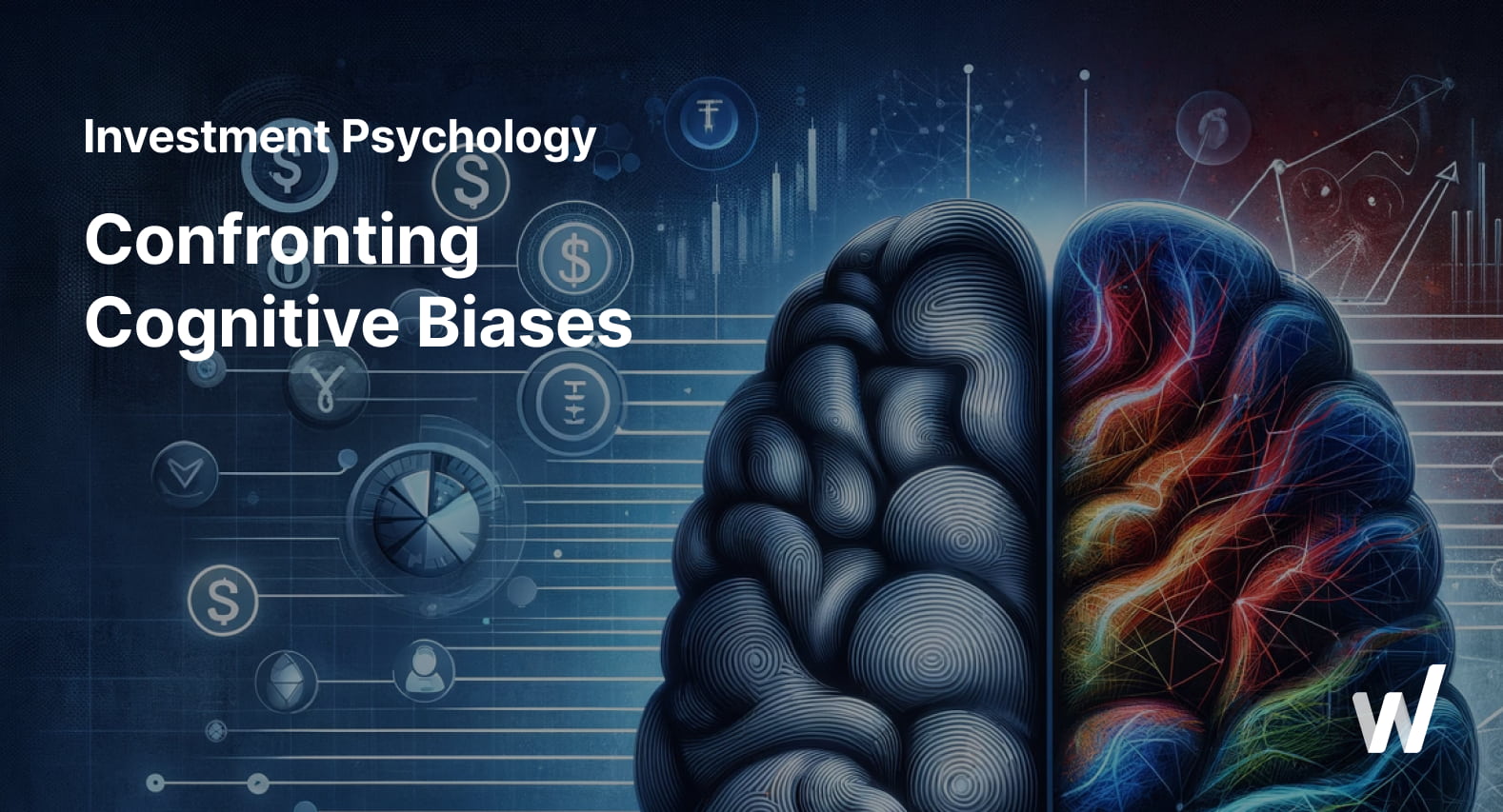Investment Psychology: Confronting Cognitive Biases
Discover how behavioural finance and cognitive biases—herding, overconfidence, loss aversion—shape investor decisions and strategies.

Decisions, factors and biases - a trio orchestrating the intricate ballet of choices in our daily lives. From the mundane to the monumental, every decision is a delicate dance, influenced by multiple factors and sometimes nudged by the subtle presence of bias.
When making decisions, we weigh practical and emotional factors, from the length of a coffee queue to the appeal of a brand. These elements subtly shape our choices, guided by nuanced biases such as the pull of familiarity or the anchoring effect of initial information.
Acknowledging this intricate dance between decisions, factors, and biases is key - it enriches experiences, adds complexity to choices and is a constant reminder of the nuanced interplay that shapes our decision-making journey. However, when it comes to investing, a new layer of complexity emerges - the influence of cognitive biases.
Behavioral finance & Cognitive biases
Behavioural finance is a branch of finance that studies how psychological factors and cognitive biases affect financial decisions and markets. It recognises that individuals are not always rational actors and that emotions, cognitive biases and social influences play a significant role in shaping financial behaviour.
“Nothing in life is quite as important as you think it is while you’re thinking about it.”
Daniel Kahneman
Cognitive biases are systematic patterns of deviation from the norm or rationality in judgment, often leading to distorted perceptions, inaccurate judgments, illogical interpretations, or what is commonly referred to as irrationality. In behavioural finance, these biases can affect decision-making processes, leading individuals to make sub-optimal choices and impacting market dynamics.
Together, let’s face the investment decision crossroads.
Imagine standing at the crossroads of diverse investment opportunities, much like navigating the aisles of a busy supermarket. This financial supermarket's choices go beyond simply evaluating prices and past performance. Investors must consider intrinsic value, company information and their time horizon, among other factors. But this decision-making process isn't purely rational; it's heavily influenced by the biases lurking in our minds' recesses.
The impact of biases on decision-making
As investors navigate this financial supermarket, the impact of bias becomes apparent. Herding behaviour can lead to following market trends rather than conducting independent analysis. People tend to assume that financial professionals are rational. However, regardless of a person's interest or field of work, we are all human, and everyone is a part of bounded rationality.
.png)
Cartoon comparing bounded and unbounded rationality in decision-making, showing simple preference for berry vs complex calculations.
Bounded rationality is the recognition of the inherent limitations of human cognitive abilities when making decisions. Developed by economist Herbert A. Simon, the idea is that individuals are bound by constraints such as limited information, cognitive capacity and time, which prevent them from consistently making perfectly rational decisions. Rather than constantly optimising, individuals often engage in "satisficing", choosing satisfactory options given the available information and constraints.
Wall Street Cheat Sheet has created the Psychology of a Market Cycle graph to show investors' changing emotions based on the price and time. The graph below shows a wave pattern that illustrates how layers of complexity can accumulate when considering a spectrum of emotions and incorporating elements such as buy/sell calls, diversification options and various strategic components.
.png)
The most common biases influencing investor decisions
A closer look reveals several cognitive biases that often affect investors, influencing their choices and, in turn, market dynamics. Drawing on insights from a comprehensive survey conducted by the CFA Institute that captured the perspectives of 724 practitioners worldwide, this research sheds light on the five primary biases - herding, confirmation, overconfidence, availability and loss aversion - that commonly shape investor behaviour.
.png)
Herding
Investors tend to follow the crowd, which often results in the need for more independent analysis and decision-making. This behaviour can contribute to market bubbles and panics as investors make decisions based on the actions of others rather than on fundamental analysis. This was the case with the dot-com bubble in the late 1990s, when investors rushed to buy into internet companies without sufficient analysis, leading to a market crash. Investors should prioritise independent research, diversify their portfolios and critically assess market trends to counter herding. This means not blindly following the consensus but making informed decisions based on thorough analysis.
Confirmation
The challenge of seeking information that matches pre-existing beliefs, potentially creating a closed loop of reinforced perspectives. This bias significantly impacts decision-making, leading to a failure to consider alternative viewpoints, resulting in sub-optimal decisions and missed opportunities. An investor may continue to invest in a particular sector, ignoring negative data about its prospects, simply because he has always invested in that sector - as in the case of Enron, where investors continued to support and invest in the company despite warning signs because of their previous positive beliefs about the company's performance in the early 2000s. But to overcome this bias, investors should actively seek information that challenges their beliefs, encourage diverse perspectives and adopt a systematic approach to decision-making using various data sources.
Overconfidence
Overconfidence manifests as an inflated sense of one's abilities, leading to excessive risk-taking and neglect of potential downsides. This can have serious consequences as investors overestimate their ability to predict market movements, leading to unwarranted risks and potential financial losses. This could also be an example of the dot-com bubble, where investors overestimated their ability to predict the 'next big thing'. Investors should remain humble, regularly re-evaluate their assumptions, and diversify their investments to spread risk more effectively and mitigate overconfidence.
Availability
Availability bias occurs when decisions are disproportionately influenced by recent or easily recalled information. This bias can lead investors to overemphasise recent events, overlook historical context, and base decisions on short-term trends. A typical scenario is a knee-jerk reaction to recent market downturns without considering longer-term market cycles. As with the reaction to the COVID-19 pandemic in early 2020, many investors quickly sold stocks in a short-term panic, ignoring the historical resilience of markets over longer periods. However, investors should take a longer-term view, conduct thorough research and avoid making decisions based solely on recent events or news.
Loss aversion
Loss aversion is the tendency to fear losses more than to celebrate gains, which can lead to overly conservative investment decisions. This behaviour affects investors by causing them to pass up growth opportunities to avoid losses, negatively impacting long-term portfolio performance. This was seen during the 2008 financial crisis when many investors sold their declining assets at low prices to avoid further losses and missed the subsequent market recovery. Investors should focus on the overall risk-return profile of their portfolios, set realistic expectations and adopt a disciplined approach that weighs both potential gains and losses to manage loss aversion.
Conclusion: A strategic investment journey
As we embark on our investment journey, we must recognise that decisions are not made in a vacuum. We are all human. Behavioural finance teaches us that biases can influence our decisions and sometimes lead us astray. However, armed with awareness and strategic approaches, investors can navigate the complexities of the financial world and make decisions based on wisdom and prudence. The investment landscape may be complicated, but with a clear mindset and informed decisions, success in achieving financial goals becomes an attainable reality.
Subsribe to our weekly newsletter
Get our Sunday morning newsletter with exclusive deals, portfolio updates, and private market insights delivered straight to your inbox.




